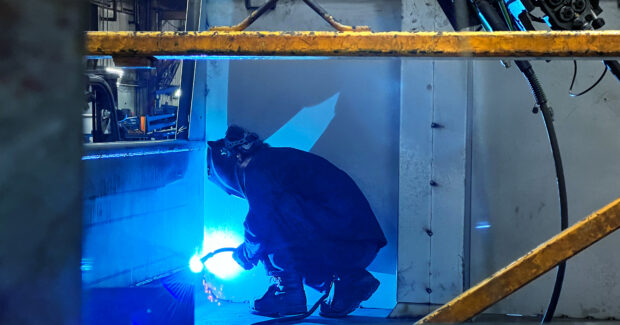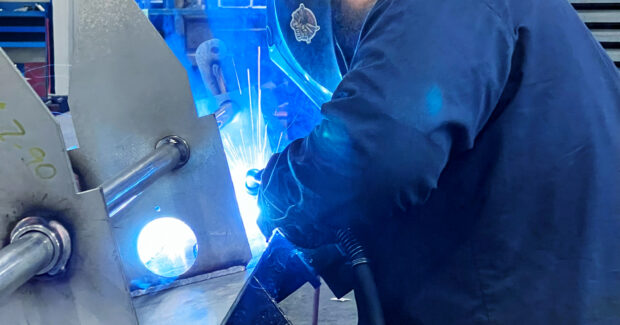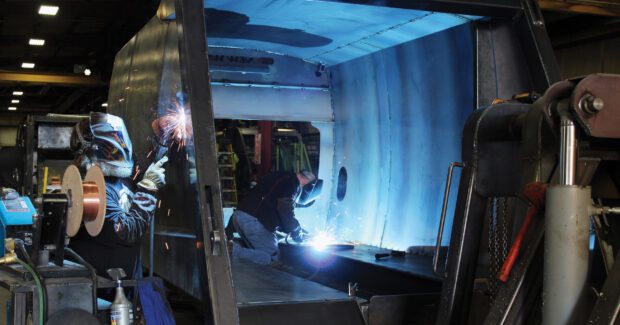How to Choose the Best Welding Process for Manufacturing
Understand common welding processes and how they impact your operation to boost productivity and optimize results.
Posted: January 17, 2023
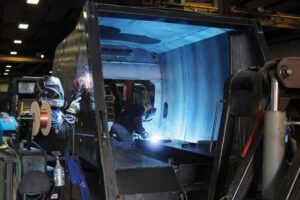
There are many different welding processes available on welding power sources designed for industrial manufacturing. So how do operations choose the process that can best deliver the results they want?
It’s important to consider your welding application needs and the goals of your operation when selecting a welding process. This can help you enhance efficiency and productivity, reduce weld defects and quickly address troubleshooting that can negatively affect your quality and throughput when the wrong process is used for the job.
First, be sure to familiarize yourself with the basics of the common welding processes used in manufacturing applications and how they can affect your operation.
CV MIG Process
Constant voltage (CV) MIG is the most basic of the wire-fed processes. As the name implies, it provides a constant voltage output. There are three common transfer modes when using CV MIG:
- Short-circuit: With low currents and voltages, this mode is good for thinner materials. It can also be used in all positions. However, short-circuit MIG is not a good choice for thicker base materials or joints where achieving penetration may be difficult. Spatter can also be an issue with this mode, resulting in more time spent on cleanup.
- Spray: With high currents and voltages and a very stable open arc, this mode is typically used on thicker materials in flat and horizontal positions. It’s not recommended to use spray transfer on thinner base materials or in applications where burn-through is a concern.
- Globular: This mode, which falls between short circuit and spray, results in an unstable welding process and is not recommended. Globular processes often occur inadvertently; they can happen when voltage or current are too low in spray transfer mode or when voltage or current are too high in the short-circuit transfer mode.
Pulsed MIG Processes
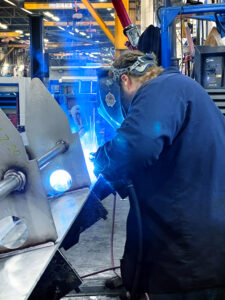
There are numerous options for pulsed MIG welding. Among the pulsed MIG options from Miller, Accu-Pulse® is the most standard pulsed arc. It is an open-arc process similar to CV spray transfer MIG, but this process is stable throughout the entire wire speed range — avoiding the lack of fusion, poor bead profiles and spatter problems commonly seen with globular transfer. The output is pulsed to facilitate a ball transfer at the pulse wave’s peak voltage and current and a cooling effect during the voltage and current background. This process adapts to operator variations in stickout, which provides a 28% wider operating window that makes it easier for operators to produce high-quality welds. It also handles the widest variety of material thicknesses and can be used in all welding positions with solid or metal-cored wire, making it a good all-purpose welding process.
Another pulsed option from Miller is the Versa-Pulse™ process, which features a tight but stable welding arc designed for high speed. It provides the fastest travel speeds and is well-suited for small fillet welds and gauge material thicknesses. It’s typically used with solid wire and can be run with most metals, but not with aluminum.
Modified Short-circuit MIG Process
A modified short-circuit MIG process, such as Regulated Metal Deposition (RMD®) from Miller, provides more operator control, a calmer weld puddle and less spatter compared to conventional CV short-circuit MIG. This process can be used on thinner-gauge material and is commonly used to fill gaps or weld open roots. RMD is typically used with solid wire, and it can be run with most metals, but not with aluminum.
Four Tips for Choosing a Welding Process
To determine the best welding process for your operation, it’s important to consider what you weld most often and what your goals are. Below are four key tips to keep in mind.
Tip 1: Consider material thickness.
One of the most important factors in choosing a process is the range of material thicknesses that are routinely welded in your operation.
The base material thickness governs how much heat can be put into the weld without burning through or how much heat needs to be placed into the joint to ensure acceptable penetration. Material up to 1/8-inch thick is well suited for CV MIG short circuit or RMD processes. On thin-gauge materials, short-circuit MIG is commonly used. However, RMD may allow a more controllable weld puddle, with less spatter and more reliable sidewall fusion. Thicker materials are well suited for Accu-Pulse or CV Spray.
In applications where the base material is up to 3/16-inch thick, the Versa-Pulse process can place small fillet welds quickly, providing high travel speeds that boost productivity.
Tip 2: Think about your most common weld positions.
Does your operation do a lot of out-of-position welding, or can most welds be fixtured and positioned for flat welding in place? A large weldment with dozens or hundreds of welds likely means that not all of the welds will be optimally positioned for in-position welding every time. Doing both in-position and out-of-position welding requires a process that provides flexibility.
Compared to CV MIG spray, pulsed MIG allows more flexibility for welding out of position by keeping the weld puddle controllable for an operator to place vertical uphill welds on thicker materials.
Tip 3: Choose a process suited for all the materials you weld.
Certain welding processes are better suited for certain materials, whether you’re using aluminum, steel or stainless steel.
Welding thick aluminum, for example, typically is best with pulsed MIG or CV MIG (in spray transfer mode). These processes provide better fusion to the root, and it can be difficult to get heat to the root when welding thick aluminum. Higher heat processes also create a more fluid weld puddle, allowing time for hydrogen to outgas from the weld to reduce porosity.
Stainless steel has other welding process options, including RMD, pulsed MIG or conventional short-circuit MIG. These processes have lower heat input and help minimize warping and burn-through. For thicker stainless steel, pulsed MIG or CV spray are commonly used.
Tip 4: Keep your operational goals in mind.
The goals of your operation play a role in choosing the right welding process. Is your top priority increasing productivity, or is your biggest challenge finding and training new welders? Different welding processes can deliver different benefits that can help you reduce costs or throughput time.
Pulsed MIG offers a more forgiving operating window, so welders of all skill levels can get good fusion into the root and sidewall to produce quality welds. Pulsed MIG also results in reduced spatter, reducing the amount of time spent on rework and cleanup. The RMD process is great for thin materials and open roots and also produces less spatter — resulting in less time and money spent on clean up. And because the Versa-Pulse process is designed for speed, you get more productivity from your welders on gauge material thicknesses.
Optimize Results with the Right Process
Many variables play a role in selecting the right welding process for your needs. Consider the pros and cons of the common processes used in manufacturing and think about key factors in your operation to help make the choice.
Subscribe to learn the latest in manufacturing.





